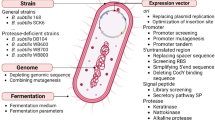Abstract
Purification of the membrane-associated epoxide hydrolase from the yeast Rhodosporidium toruloides CBS 0349 to electrophoretic homogeneity was achieved in a single chromatographic step employing the affinity ligand adsorbent Mimetic Green. More than 68% of the total epoxide hydrolase activity present in the whole cells was recovered from the membrane fraction. The enzyme was purified 26-fold with respect to the solubilized membrane proteins and was obtained in a 90% yield. The purified epoxide hydrolase has an apparent monomeric molecular weight of ∼54 kDa, and a pI of 7.3. The enzyme was optimally active at 30–40 °C, and pH 7.3–8.5. The enzyme is highly glycosylated with a carbohydrate content >42%. The specific activity of the purified enzyme for (±)-1,2-epoxyoctane is 172 μmol min−1 mg protein−1. The amino acid composition of the protein was determined. This is the first report of a yeast epoxide hydrolase purified to homogeneity in milligram amounts.
Similar content being viewed by others
References
Archelas A (1998) Fungal epoxide hydrolases: new tools for the synthesis of enantiopure epoxides and diols. J. Mol. Catalysis B: Enzymatic 5: 79–85.
Archelas A, Furstoss R (1998) Epoxide hydrolases: new tools for the synthesis of fine organic chemicals. TIBTECH 16: 108–116.
Blèe E, Schuber F (1992) Occurrence of fatty acid epoxide hydrolases in soybean (Glycine max). Biochem. J. 282: 711–714.
Botes AL, Weijers CA, Van Dyk MS (1998) Biocatalytic resolution of 1,2-epoxyoctane using resting cells of different yeast strains with novel epoxide hydrolase activities. Biotechnol. Lett. 20: 421–426.
Cleij M, Archelas A, Furstoss R (1998) Microbiological Transformations — Part 42 — A 2-liquid-phase preparative-scale process for an epoxide hydrolase catalyzed resolution of para-bromo-alpha-methyl styrene oxide — occurrence of a surprising enantioselectivity enhancement. Tetrahedron: Asymmetry 9: 1839–1842.
Dong MW, Grant JR (1985) High-speed liquid chromatographic analysis of amino acids by post-column sodium hypochlorite-o-phthalaldehyde reaction. J. Chromatogr. 327: 17–25.
Jacobs MHJ, van den Wijngaard AJ, Pentenga M, Janssen DB (1991) Characterization of the epoxide hydrolase from an epichlorohydrin degrading Pseudomonas sp. Eur. J. Biochem. 202: 1217–1222.
Käppeli O, Sauer M, Fiechter A (1982) Convenient procedure for the isolation of highly enriched, cytochrome P-450 containing microsomal fraction from Candida tropicalis. Anal. Biochem. 126: 179–182.
Kroutil W, Genzel Y, Pietzsch M, Syldatk C, Faber K (1998) Purification and characterization of a highly selective epoxide hydrolase from Nocardia sp. Eh1. J. Biotechnol. 61: 143–150.
Lu AYH, Thomas PE, Ryan D, Jerina DM, Levin W (1979) Purification of human liver microsomal epoxide hydrase. J. Biol. Chem. 254: 5878–5881.
Misawa E, Chion CK, Archer IV, Woodland MP, Zhou NY, Carter SF, Widdowson DA, Leak DJ (1998) Characterization of a catabolic epoxide hydrolase from a Corynebacterium sp. Eur. J. Biochem. 253: 173–183.
Mischitz M, Faber K, Willets AJ (1995) Isolation of a highly enantioselective epoxide hydrolase from Rhodococcus sp. NCIMB 11216. Biotechnol. Lett. 17: 893–898.
Morisseau C, Nellaiah H, Archelas A, Furstoss R, Baratti JC (1997) Asymmetric hydrolysis of racemic para-nitrostyrene oxide using an epoxide hydrolase preparation from Aspergillus niger. Enzyme Microbiol. Technol. 20: 446–452.
Porter TD, Beck TW, Kasper CB (1986) Complementary DNA and amino acid sequence of rat liver microsomal, xenobiotic epoxide hydrolase. Arch. Biochem. Biophys. 248: 121–129.
Rink R, Fennema M, Smids M, Dehmel U, Janssen DB (1997) Primary structure and catalytic mechanism of the epoxide hydrolase from Agrobacterium radiobacter Ad1. J. Biol. Chem. 272: 14650–14657.
Robertso EF, Dannelly HK, Molloy PJ, Reeves HC (1987) Rapid isoelectric focussing in a vertical polyacrylamide minigel system. Anal. Biochem. 167: 290–294.
Wackett LP, Gibson DT (1982) Metabolism of xenobiotic compounds by enzymes in cell free extracts of the fungus Cunninghamella elegans. Biochem. J. 205: 117–122.
Weijers CAGM (1997) Enantioselective hydrolysis of aryl, alicyclic and aliphatic epoxides by Rhodotorula glutinis. Tetrahedron: Asymmetry 8: 639–647.
Weijers CAGM, de Bont JAM (1999) Epoxide hydrolases from yeasts and other sources: versatile tools in biocatalysis. J. Mol. Catalysis B: Enzymatic 6: 199–214.
Wixtrom RN, Silva MH, Hammock BD (1988) Affinity purification of cytosolic epoxide hydrolase using derivatized epoxy-activated sepharose gels. Anal. Biochem. 169: 71–80.
Wojtasek H, Prestwich GD (1996) An insect juvenile hormone specific epoxide hydrolase is related to vertebrate microsomal epoxide hydrolases. Biochem. Biophys. Res. Commun. 220: 323–329.
Author information
Authors and Affiliations
Rights and permissions
About this article
Cite this article
Botes, A. Affinity purification and characterization of a yeast epoxide hydrolase. Biotechnology Letters 21, 511–517 (1999). https://doi.org/10.1023/A:1005500407152
Issue Date:
DOI: https://doi.org/10.1023/A:1005500407152




